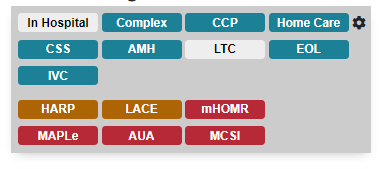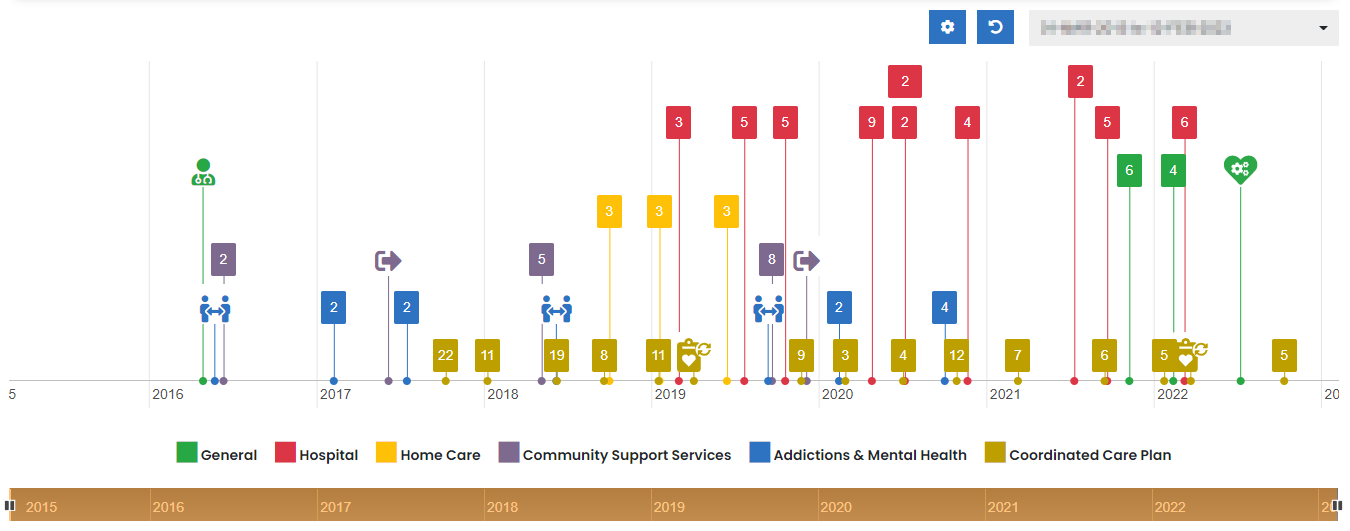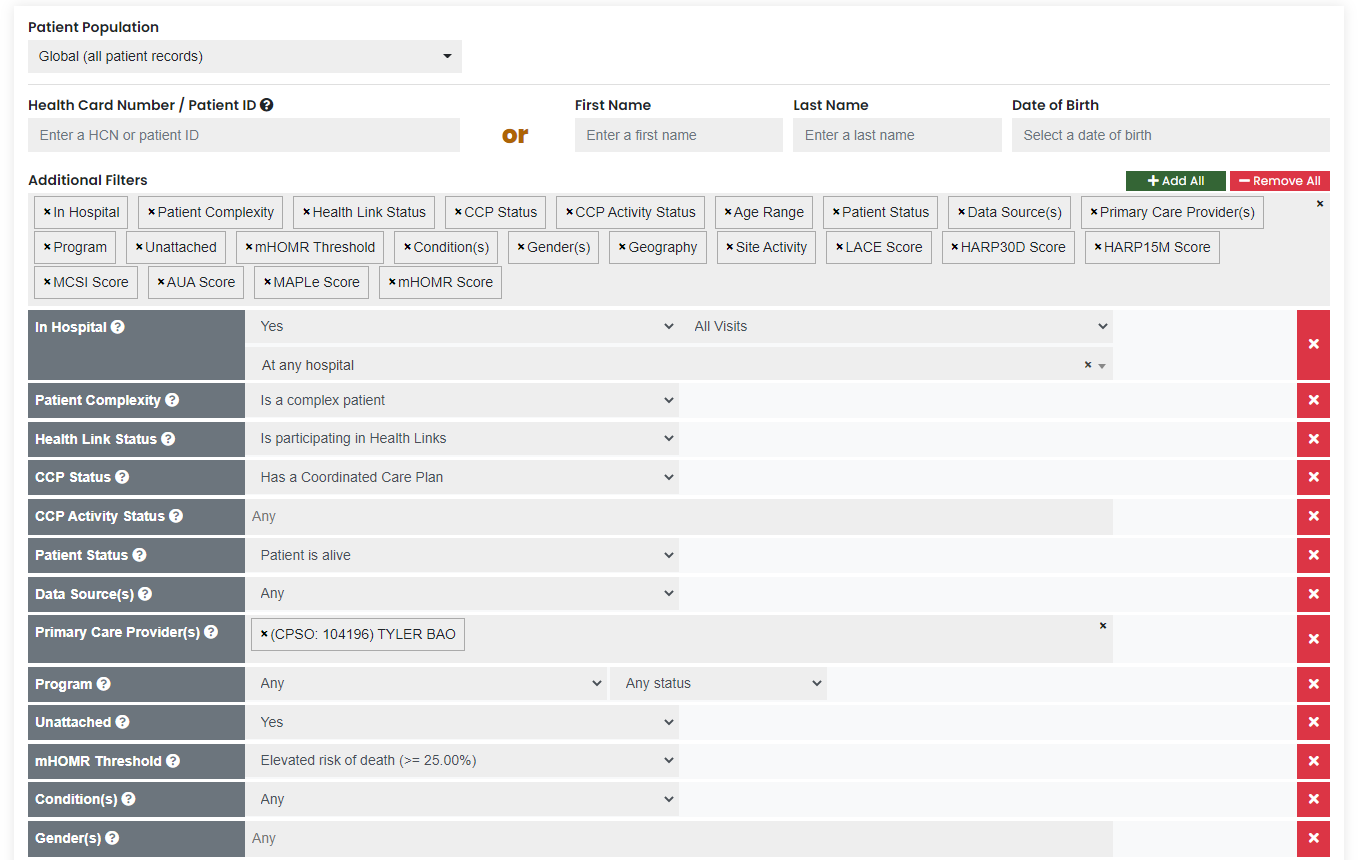Managing your patients can be easy to do using the one-to-many tools and functionality in SHIIP.

The patient-centred profile in SHIIP is where all the data contributions come together into one comprehensive patient profile. The patient profile provides a concise and consolidated view of the patient’s encounters with the health care sectors contributing data to SHIIP.
The patient profile presents patient data into several pages (tabs) and they are:

On each patient profile page, a grouping of badges are presented to provide a quick summary of the patient’s status across different sectors as well as some key patient indicators highlighting the patients risk profile. Each badge is dynamically recalculated every time a patient encounter occurs, enabling the presentation of the patient’s status in real time.

Journey
Customizable patient journey chart that displays key health sector encounters for selected patient.

SHIIP enables you to receive real-time notifications during specified patient activity or when key activities are needing to be addressed. Users can choose to be notified when a patient is visiting/leaving a hospital, or when a certain page on a patient’s Coordinated Care Plan is updated, privacy officers will receive automatic notifications when auditing functions need to be performed.
A full list of when you can be notified is below:
- Hospital inpatient admission
- Hospital inpatient discharge
- Hospital inpatient discharge with LACE score greater than a specified value
- Emergency department visit
- Discharged from emergency department visit
- Discharged from emergency department visit with HARP score greater than a specified value
- Various CCP notifications
In addition to the above notification settings, users may also choose if they would also like to be notified via email.
Note: Notifications sent via email do not include and personal health information.
Practice lists are listings of patients associated with an organization or a provider at the click of a button. If enabled, these practice lists are automatically generated for an organization or provider. A practice list includes patients that:
- Are receiving primary care from any of your organization’s assigned regulated health professionals (physicians, nurse practitioners). SHIIP is aware of a patient’s primary care provider thanks to it’s integrations with a variety of acute care facilities. A patient’s primary care provider is generally reported at the time of admission.
- Have visited a health care site that is assigned to your organization. This can include hospitals, community support services, addictions & mental health agencies, and home & community care agencies.
What can be done with a practice list?
Practice lists are a subset of patients that have a relationship with your organizations. They can be used for quicker access to patient profiles, and quicker results when viewing patient activity and dashboards. A practice list also enables you to run advanced searches on it’s patients, allowing you to find patients eligible for a Coordinated Care Plan (CCP), patients that have been active at a health care site in the past week, etc. The available filters provide a great deal of flexibility so that you can find exactly who you are looking for.
Patient lists are manually controlled by SHIIP users. A user can create as many lists as they like, with the ability to set a name and description at the time of creation. While a manual list is a simple concept, they can provide a great deal of flexibility for any type of user. Below are some example uses for a patient list:
- Your own ‘caseload’
- Your complex patients
- Your patients requiring data entry
- Your patients with a Coordinated Care Plan
- Your patients currently receiving palliative care
- Your patients requiring follow-up after a visit to an acute care facility
The Program Management feature in SHIIP is a new feature that enables users to view and manage patients within programs. Programs can be defined with several options that provide flexibility for all clinical workflows and, like other SHIIP features, we will expand on this in upcoming releases. Below are some highlights for this feature.
Custom Permissions (Programs can be created with the following permissions):
- Owner(s)
- Manager(s)
- Viewer(s)
Programs can be owned by one or more organizations. For managing and viewing, permissions can be added to individual users if necessary.
Search for one patient, search for groups of patients with the same identifiers.
Patients or clients are always just a few clicks away in SHIIP – if speed is priority, you can find patients using the quick patient search located at the top-right of any SHIIP page. If you preferred to use advanced search filters to find a specific subset of your patients, you can navigate to the advanced search page using the top navigation bar.
Quick Patient Search
SHIIP’s quick patient search is located at the top-right corner of every SHIIP page. It can provide access to any patient in the system, provided you have the required information. Below are the search types available in this feature:
- By partial last name, first name, or health card number – this will search through your organization’s practice list. To protect patient privacy, we limit this to only patients whom have a relationship with your organization.
- By full last name, first name, and date of birth – this will search through all the patients in SHIIP. It must follow the exact format of “Last, First, 1900-12-30”.
- By full health card number – this will search through all of the patients in SHIIP.
- By full patient ID – this will search through all patients in SHIIP. A patient ID is unique to SHIIP, and is a secure way to identify patients in email or other communications.
Advanced Patient Search
The advanced search capabilities in SHIIP providers users the capabilities to search and seek patients using up to twenty-two predefined filters that are available in the SHIIP system.

Each of the above filters works in an ‘AND’ fashion – meaning, the more filters you add, the slimmer and more focused your results will be. Any combination of the above filters can be saved and used in other areas of SHIIP such as the Home page.
With these flexible querying capabilities users can seek for patient population groups and create custom population groups and use SHIIP mechanisms to track and monitoring key patient encounters, patient indicators and care planning activities.
Saved Searches
SHIIP allows you to save your search filters in what we call ‘Saved Searches’. Saved Searches can be used throughout the application as a standalone patient population. If you would like to see patient activity for your organization’s complex patients, you can do that! The flexibility of saved searches should serve just about any workflow.